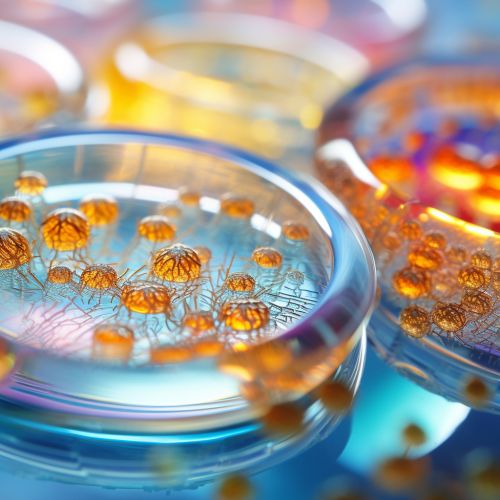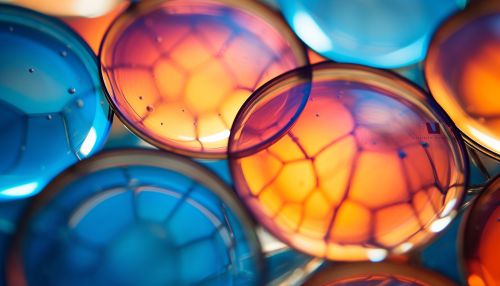Cell culture
Introduction
Cell culture is a fundamental technique in the field of cellular biology, where cells are grown under controlled conditions, generally outside their natural environment. The practice of cell culture has allowed scientists to investigate the physiology and biochemistry of cells (cell metabolism), the effects of drugs and toxic compounds on cells, and to mutate cells to new strains. It also provides a platform for studying the effects of biologicals and chemicals on biological processes.
History
The development of cell culture techniques dates back to the early 20th century, with the first significant breakthrough occurring in 1907 when Ross Harrison demonstrated the in vitro culture of frog nerve fiber. Later, in the 1950s, the development of antibiotics and the discovery of HeLa cells by George Gey allowed for the establishment of cell culture as a major tool in biological research.
Types of Cell Culture
There are several types of cell culture techniques, each with its own specific applications and requirements. These include:
Primary Cell Culture
Primary cell culture involves the extraction and maintenance of cells directly from the tissue of an organism. These cells have a limited lifespan and are more difficult to maintain than cell lines. However, they are more representative of the in vivo state and are therefore used in studies where this is important.
Cell Lines
Cell lines are a type of cell culture that has been subcultured many times and can be maintained indefinitely in vitro. They are often derived from tumors and are therefore immortal. Cell lines are easy to handle, but they may not represent normal cells as they often carry mutations.
Stem Cell Culture
Stem cell culture involves the growth and differentiation of stem cells, which are cells that have the ability to develop into many different types of cells in the body. This type of cell culture is used in regenerative medicine and developmental biology.
Cell Culture Techniques
Cell culture techniques vary depending on the type of cell being cultured and the specific requirements of the experiment. However, there are some general steps that are followed in most cell culture procedures.
Cell Seeding
The process begins with cell seeding, where cells are placed in a culture dish containing a nutrient-rich medium. The cells adhere to the dish and begin to proliferate.
Cell Maintenance
Cell maintenance involves regularly changing the medium to provide fresh nutrients and remove waste products. The cells are also monitored for contamination and morphological changes.
Cell Passaging
Once the cells reach confluence (when they cover the entire surface of the dish), they need to be passaged. This involves detaching the cells from the dish, diluting them, and placing them in a new dish. This allows for the continued growth of the cells.
Applications of Cell Culture
Cell culture has a wide range of applications in various fields of biological research. Some of the key applications include:
Drug Testing and Development
Cell culture is used in the testing and development of new drugs. It allows for the testing of drug efficacy and toxicity on a cellular level before proceeding to animal and human trials.
Vaccine Production
Many vaccines are produced using cell culture techniques. For example, the polio vaccine is produced by growing the poliovirus in monkey kidney cells.
Cancer Research
Cell culture is a key tool in cancer research. It allows for the study of cancer cell growth and proliferation, and the testing of potential anti-cancer drugs.
Regenerative Medicine
In regenerative medicine, cell culture techniques are used to grow new cells and tissues that can be used to replace damaged or diseased tissues in the body.
Challenges in Cell Culture
Despite its many applications, cell culture is not without its challenges. These include:
Contamination
Contamination is a major issue in cell culture. It can come from various sources such as the air, water, equipment, and even the cell culture medium. Contamination can lead to the loss of a cell culture and can also affect the results of experiments.
Cell Line Authentication
Another challenge is cell line authentication. Many cell lines have been cross-contaminated or misidentified over the years. This can lead to the use of incorrect or contaminated cell lines in research, which can affect the validity of the results.
Ethical Issues
There are also ethical issues associated with cell culture, particularly when it comes to the use of human cells. These include issues of consent, privacy, and the potential for commercial exploitation.
Future of Cell Culture
The future of cell culture lies in the development of more sophisticated and representative models of human physiology. This includes the development of organ-on-a-chip and body-on-a-chip technologies, which aim to mimic the complex structure and function of human organs and systems in vitro. These technologies could revolutionize drug development and personalized medicine, and reduce the need for animal testing.
See Also


